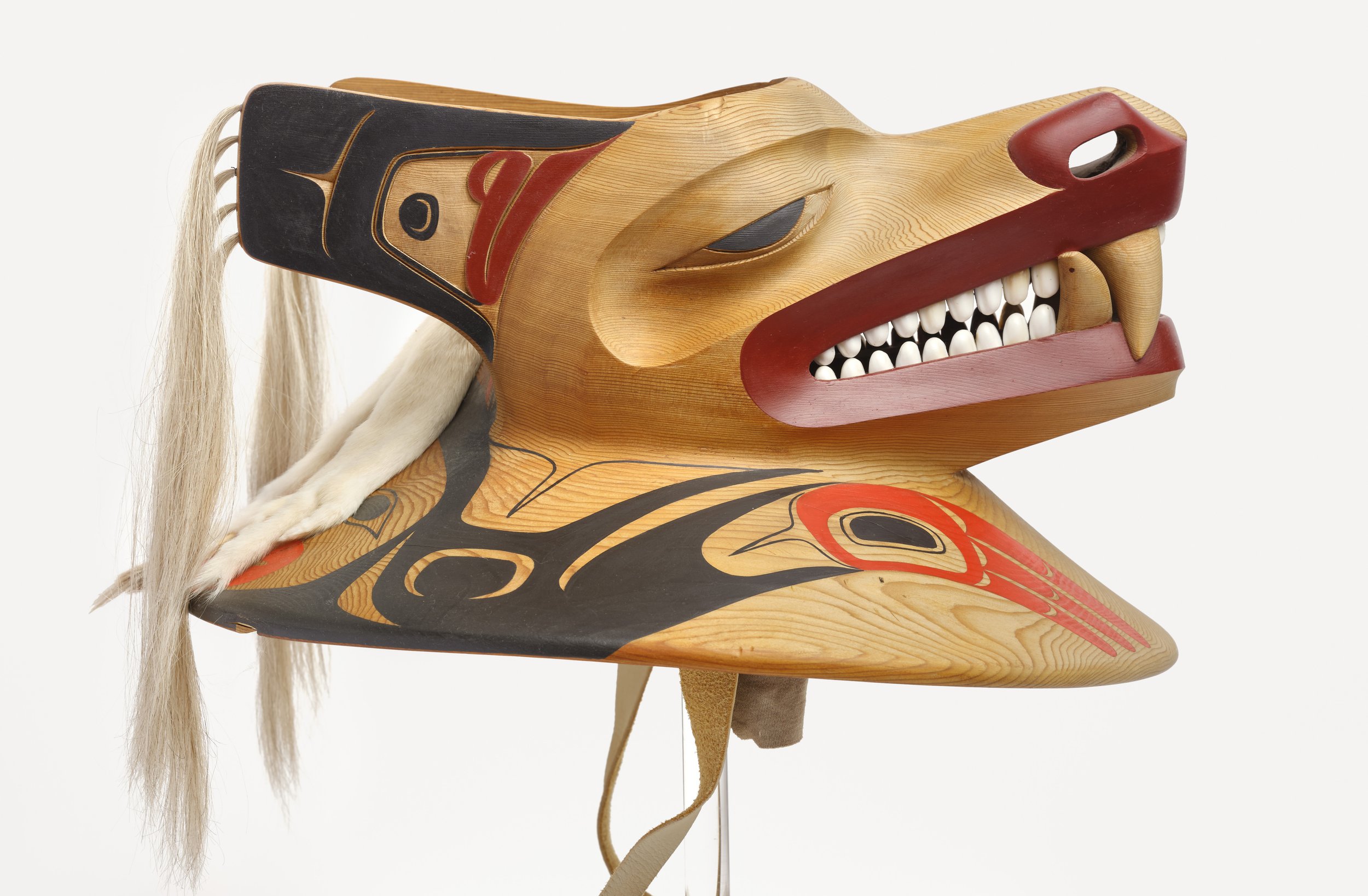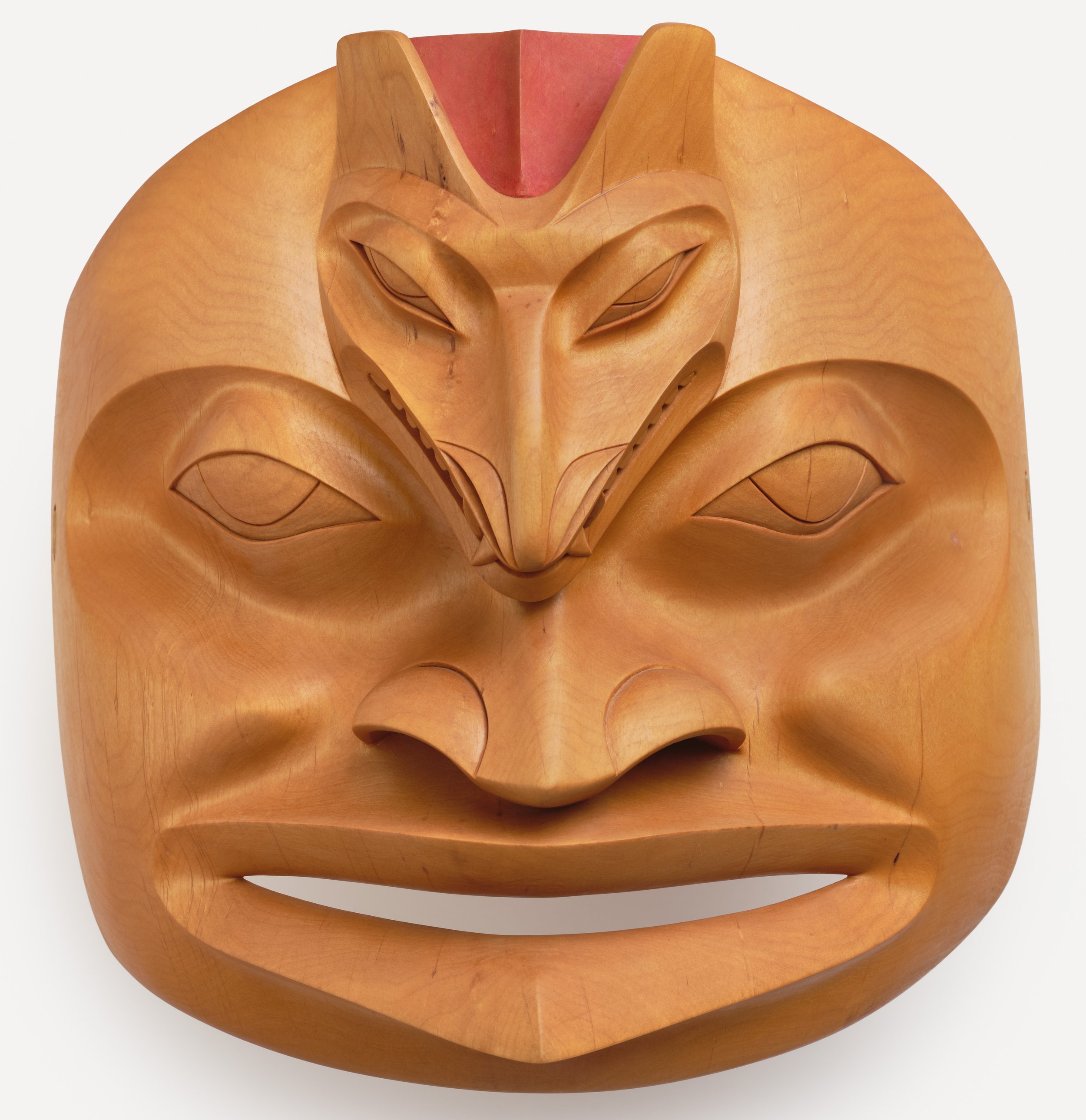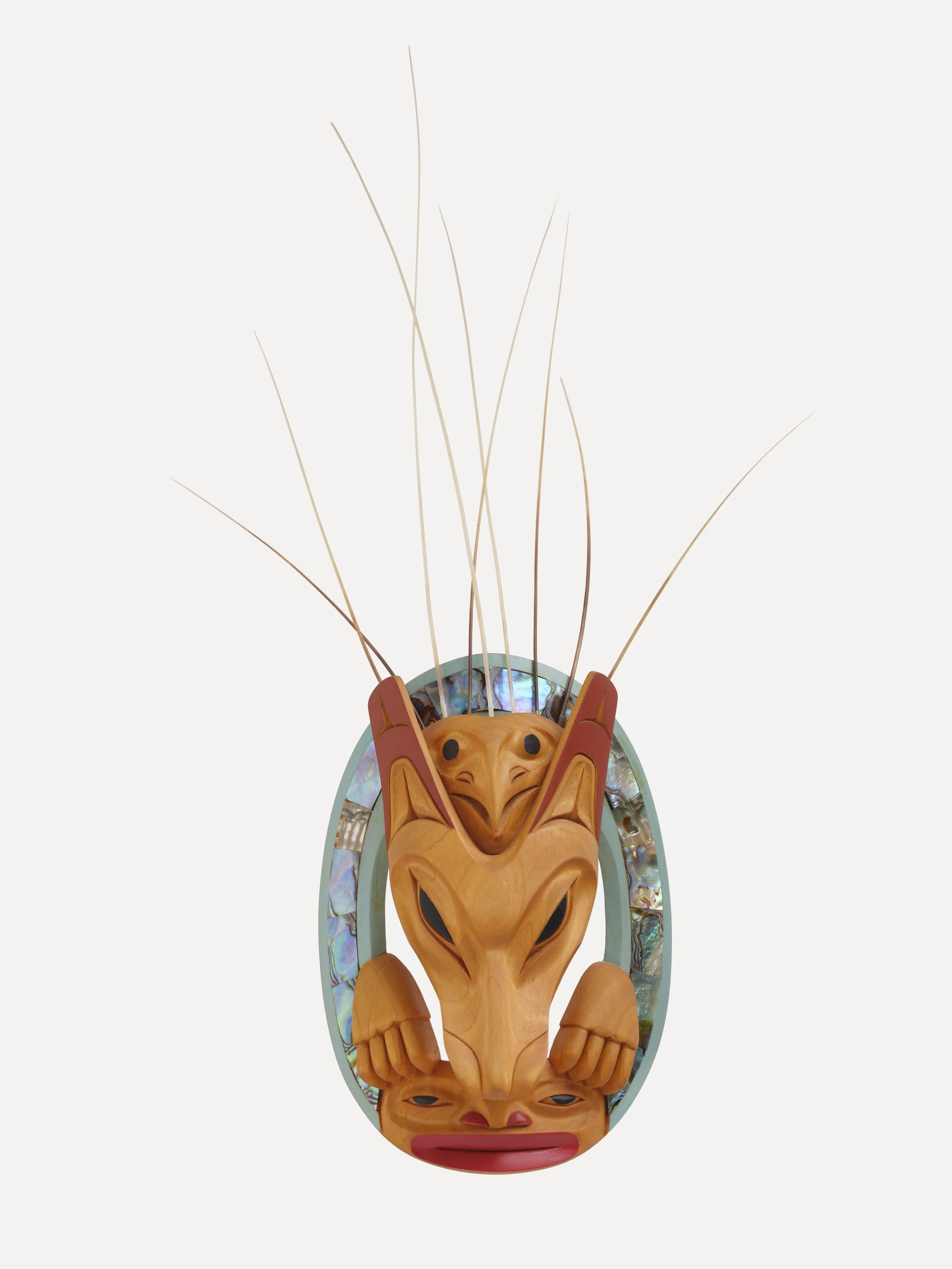Tahltan-Tlingit artist Dempsey Bob carves his culture
The first-ever retrospective of the master carver’s career is being held at Audain Art Museum
Dempsey Bob, Wolf Chief’s Hat, c. 1993; red cedar, acrylic paint, operculum shell, horsehair, leather, ermine. Collection of Eric Savics. Photo by Rachel Topham Photography
Audain Art Museum presents Wolves: The Art of Dempsey Bob, a co-production of the Audain Art Museum and McMichael Canadian Art Collection, at Audain Art Museum in Whistler from April 2 to August 14.
TAHLTAN-TLINGIT ARTIST Dempsey Bob, a member of the Wolf Clan, has been carving ever since he was a youngster. Born in Telegraph Creek in northern B.C., he grew up in Port Edward, just outside of Prince Rupert, where his parents worked at a cannery. His list of accolades is long: Bob received a Lifetime Achievement Award in Aboriginal Art in 2007, was named an Officer of the Order of Canada in 2013, and earned a 2021 Governor General’s Award in Visual and Media Arts. Bob’s works have been displayed at Canada House in London, the Smithsonian Institution, Japan’s National Museum of Ethnology, Hamburgisches Museum fur Volkerskkunde in Hamburg, and Vancouver Art Gallery, among many others. And yet the vast majority of the pieces from his 50-plus-year career have not been widely seen by the people of B.C. or beyond, being mostly in the hands of private collectors (an interesting backstory in itself). That’s what makes Wolves: The Art of Dempsey Bob at Audain Art Museum so significant.
The first-ever retrospective of the master carver’s career, the exhibition co-produced by Audain Art Museum and McMichael Canadian Art Collection features more than 100 works from the 1970s to the present loaned from public and private collections. On display is a critical selection of masks, headdresses, wall sculptures, regalia, bronze casting, jewellery, goldsmithing, printmaking, and more. Bob describes it as a once-in-a-lifetime experience.
“What’s happened with my work is that all these pieces went into private collections and museums; over the years I had two or three collectors who bought everything I made,” Bob says in a Zoom interview from the Terrace home he shares with his wife, Margaret; Audain Art Museum curator Curtis Collins is on the call from Whistler. “This one guy, I did his whole house. So people haven’t really seen my work. They’ve seen pieces of it in books or magazines. What’s going to happen here for the first time is they are going to really see what I did; most people don’t know. That’s the most amazing part of it. There’s never going to be 100 pieces like that of my work in one place again.
“This exhibition is important because it’s part of history now—our history and part of Canada, too,” he says. “It’s an artform that was almost lost, but we brought it back. I’m trying to honour my ancestors. It’s about honouring—that’s what I’m doing.”
Bob is from the Wolf Clan via matrilineal descent, and he wanted to name the exhibition Wolves as a tribute to his mother and grandmother.
“When I started, they were the only ones who supported me,” says Bob, whose great grandfather was a carver and father was a carpenter. “When you’re young, people don’t believe in you. It was a struggle, because there was no market: we had to build the market. We used to call it ‘starving and carving’; we were living on the edge the whole time. We couldn't get any recognition in Canada, so we started going to the States, selling there. Then we started to get recognition in our own country.”
Bob shares a story of going to public school in Prince George, where his art teacher gave him a C-minus and said she was going to fail him. When he asked her why, she said: “You don’t draw the way I want you to draw.” “I said, ‘Well, I’m Tahltan and Tlingit, and that’s the way I see it. I can’t deny who I am; that’s how I draw. I can’t deny who my grandmothers are and who my grandfathers are.’ I stuck to my guns. She made me so mad. But she made me determined.
“I went back there for a reunion—I had just won the Officer of the Order of Canada,” he adds. “She wasn’t there. I realize now that was her job to make me mad. I don’t know if I would have been so determined.”
Dempsey Bob, Wolf Human Mask, 1992; alder, wood, and acrylic paint. Collection of Eric Savics. Photo by Rachel Topham Photography
Bob remembers carving wood as a kid, making things like bows and arrows, slingshots, swords, and canoes. With no TV at home, he and his brother would flip through Simpsons-Sears’ catalogues to get ideas to make their own toys. Bob’s formal training began in 1969, when he started to study under Freda Diesing, a renowned Haida carver and one of the few women to make Northwest Coast totem poles. A mentor to him, Diesing had a profound influence on Bob, who went on to study at the Gitanmaax School of Northwest Coast Indian Art and Design in Hazleton. While most of his works are in cedar and alder, he expanded his repertoire to include bronze casting after studying at Boise State University in 1992.
Bob says he met Diesing by fluke, having joined two friends who happened to be going to one of her classes. “I had no tools, so I borrowed my brother’s tools and I went carving with them,” Bob recalls. “When I was working with Freda, I had this great feeling that’s what I wanted to do. It was a good feeling with the wood. It felt right.
“I used to watch my dad work with wood,” he says. “When I met Freda, I was ready to learn. Freda was a really great teacher because she gave us tools to find out what our Tlingit and Tahltan style was, where to find that information, what museums to go to and which books to look at and to study, because we didn’t have anything else. All of our things were all over the world, and she gave us tools to find out what we needed to know. When people ask me where I went to art school, I say I went to art school at the Prince Rupert library. They have this collection of old First Nations art history books and art books—you can’t take them out but you look at them and study them. That's all we had all we had. When Freda started teaching us, she was our thread to our culture.”
Bob notes that some artists didn’t want to learn from her because she was female, and in traditional culture, only men were master carvers, while women did other forms like weaving. He’s ever grateful for the way she urged him to study, practice, and improve—such as when she insisted he learn to draw from esteemed artists in Alaska.
“When I started carving I didn’t want to draw,” Bob says. “I realized after I drew about 2,000 ovoids why she sent me. I couldn’t get any better as a carver because my drawing wasn’t there. In art, drawing is the foundation. Drawing is the language of art. If my drawings couldn’t get better, my carvings couldn’t get better. The best drawers are the best carvers.
“I realized you’ve got to do your homework to mature as an artist,” he adds. “If you stop learning, you stop being an artist. That means learning how to draw, learning about sculpture, learning about wood, learning about art history, learning stories and understanding them, learning your culture. That’s what I did.”
Bob continues to push Northwest Coast art traditions forward, teaching young people and serving as a senior advisor to the Freda Diesing School of Northwest Coast Arts at Coast Mountain College.
Dempsey Bob wearing Killer Whale Headdress and holding Eagle Human Mask and Eagle Bear Mask, all of 1987, in University of British Columbia, Museum of Anthropology collection. Photograph courtesy of Dempsey and Margaret Bob.
It was in Toronto in 1986 that Bob first met Collins, who was then assistant curator for New Beginnings, part of the Native Business Summit. Collins says he was immediately struck by Bob’s art and visited him in Prince Rupert in the mid-1990s while working on a research project. Upon joining Audain Art Museum in 2018, high on Collins’s priority list was executing an exhibition of Bob’s artwork. Collins says Wolves is one of the most important events the museum has mounted to date and is by far the most meaningful exhibition for him on a professional and personal level.
“It’s been 30 years in the making,” Collins says with a laugh. “It’s a very special experience for me, and in a curatorial context to have all of the pieces here in one place is pretty amazing. It’s a really beautiful presentation, and it was important to have a cross-section of works to show the different aspects of Dempsey’s work. There is lots of variety of works and things you can think about in terms of how that relates to the past and the present and how we think about the future. It’s a really good opportunity to show people how traditions move forward and how that’s a really positive process—and one that got interrupted.
“Dempsey said that Freda that was that thread; that thread is now a rope, and it’s going to get thicker,” he says. “This is the responsibility that museums have in Canada and all over the world, and we need to take that responsibility.”
Dempsey Bob, Wolf Eagle Frontlet, 1996; alder wood, acrylic paint, abalone shell, sea lion whiskers. Collection of Eric Savics. Photo by Rachel Topham Photography
In each room at the museum, viewers will see a different iteration of wolves, whether it’s a mask, print, bronze, or bowl. Among the pieces featured in Wolves is Wolf Chief’s Hat (c. 1993) and Northern Eagles Transformation Mask (2011). They’re representative of Bob’s expertise in cedar and alder and underline his characteristic torquing of form and highly polished surfaces. The exhibition illustrates his ability to manipulate materials ranging from operculum shell to sea-lion whiskers.
Also featured is Raven Panel (1989) with a mirror on one side, a piece Collins vividly remembers seeing for the first time in 1992 at the National Gallery of Canada. Old Woman Mask from 1974 plays off of a work in the Audain’s permanent collection by Diesing called Old Woman with Labret (1973); Collins strives to connect special exhibitions with the museum’s holdings to make those links between past, present, and future.
Little Frog, a long-haired creature that is half-frog, half human, bears a quality of Bob’s work that has always captured and intrigued Collins.
“There are some of his works that I’m a little bit scared of: they’re living,” Collins says. “There’s definitely an animate quality to a lot of his pieces.”
Then there’s The Smart One, an alder mask from 1989. “It hasn’t been seen since then,” Bob says. “It went to George Gunn in San Jose. He used to own the San Jose Sharks and the Cleveland Cavaliers basketball team. He had about 40 of my pieces. He passed away, and some of the pieces were auctioned off. I don’t know how we did it, but we found The Smart One. I think that mask is important because it’s one of my best, and I didn’t want it to leave Canada. I gave the Museum of Civilization a chance to buy it but didn’t get a response, so I sold it. This is the first time it’s coming back to Canada. I think someday I’ll be remembered by that.”
Bob says his grandfather told him the story of the Smart One, who was the keeper of stories, trained by elders to settle disputes between clans.
“He’s alive—this guy is alive,” Bob says. “He knows, but he’s not telling you what he knows. I drew him, but he finished the way he wanted to be finished. He was smarter than me. When I look back at it now, I just think ‘Wow, it was an honour to be part of him.’ He had a phenomenal mind.”
Images of beings or creatures like The Smart One will often come to him, Bob says, and he feels compelled to bring them to life. It’s a way of keeping story, history, family, and culture alive.
“I’ve always pushed myself and pushed my art,” Bob says. “I always wondered where our art would have went if we didn’t stop, or they didn’t stop us. Our culture was full of sculptors, designers, painters… Our culture was outlawed until 1951. I was three years old.
“It’s a struggle trying to raise a family, with no money. I was stubborn I guess,” Bob says. “My family never gave up. I believed in what I was doing and in our culture, too, and I knew how important it was. It all goes back to my mother and my grandfather and their stories—that’s what I’m doing. Sometimes I feel like I’m just the carpenter—the lucky carpenter.”
After its stay at Audain Art Museum, Wolves: The Art of Dempsey Bob travels to The McMichael Canadian Art Collection, Montreal Museum of Fine Arts, and Kelowna Art Gallery. The exhibition is accompanied by a fully illustrated hardcover book entitled Dempsey Bob: In His Own Voice.
More information is at Audain Art Museum.
















